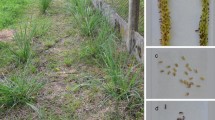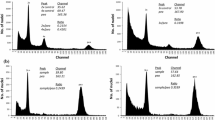Abstract
MnNC-1008(NN) (referred to as MN-1008) is a tetraploid alfalfa mutant with two recessive genes (nn 1 and nn 2 )conditioning the non-nodulating trait. The tetraploid level (2n=4x=32) of this Medicago sativa germ plasm was reduced to the diploid (2n=2x=16) level using the 4x-2x genetic cross originally described as a workable method for the induction of haploidy in alfalfa by T. E. Bingham. In our experiments more than 7000 emasculated flowers of a single non-nodulating MN-1008 mutant alfalfa plant with purple petals were cross-pollinated with pollen from a single, diploid, yellow-flowered alfalfa plant. Mature seeds from these crosses were collected and germinated, after which the plants were subjected to morphological and cytogenetic analyses as well as to DNA fingerprinting. Out of 26 viable progeny, 6 were hybrid plants, 19 proved to be self-mated derivatives of MN-1008, while one descendant turned out to be a diploid (2n=2x=16), purple flowered, non-nodulating plant denoted as M. sativa DN-1008. This diploid, non-nodulating alfalfa plant can serve as starting material to facilitate the comprehensive morphological, physiological and genetic analysis (gene mapping and cloning) of nodulation in order to learn more about the biology of the symbiotic root nodule development. To produce diploid, nodulating hybrid F1 plants, DN-1008 was crossed with a diploid, yellow-flowered M. sativa ssp. quasifalcata plant. An F2 population segregating the nn 1 and nn 2 genes in a diploid manner, in which the genetic analysis is more simple than in a tetraploid population, can be established by self-mating of the F1 plants.
Similar content being viewed by others
References
Allison LA, Kiss GB, Bauer P, Poiret M, Pierre M, Savouré A, Kondorosi E, Kondorosi A (1993) Identification of two alfalfa early nodulin genes with homology to members of the pea ENOD12 gene family. Plant Mol Biol 21:375–380
Bingham ET (1969) Haploids from cultivated alfalfa. Nature 221:865–866
Bingham ET (1971) Isolation of haploids of tetraploid alfalfa. Crop Sci 11:433–435
Bingham ET, Binek A (1969) Comparative morphology of haploids from cultivated alfalfa, Medicago sativa L. Crop Sci 9:749–751
Bingham ET, Gillies CB (1971) Chromosome pairing fertility and crossing behavior of haploids of tetraploid alfalfa Medicago sativa L. Can J Genet Cytol 13:195–202
Caetano-Anollés G, Gresshoff PM (1991) Plant genetic control of nodulation. Annu Rev Microbiol 45:345–382
Caetano-Anollés G, Joshi PA, Gresshoff PM (1993) Nodule morphogenesis in the absence of Rhizobium. In: Palacios R, Mora J, Newton WE (eds) New Horizons in Nitrogen Fixation, Kluwer Academic Press Dordrecht, The Netherlands, pp 297–302
Csanádi G, Szécsi J, Kaló P, Kiss P, Endre G, Kondorosi A, Kondorosi É, Kiss GB (1994) ENOD12, an early nodulin gene, is not required for nodule formation and efficient nitrogen fixation in alfalfa. Plant Cell 6: 201–213
Dudley ME, Long SR (1989) A non-nodulating alfalfa mutant displays neither root hair curling nor early cell division in response to Rhizobium meliloti. Plant Cell 1:65–72
Kiss GB, Csanádi G, Kálmán K, Kaló P, Ökrész L (1993) Construction of a basic genetic map for alfalfa using RFLP, RAPD, isozyme and morphological markers. Mol. Gen Genet 238, 129–137
Kondorosi A, Svab Z, Kiss GB, Dixon RA (1977) Ammonia assimilation and nitrogen fixation in Rhizobium meliloti. Mol Gen Genet 151:221–226
Peterson MA, Barnes DK (1981) Inheritance of ineffective nodulation and non-nodulation traits in alfalfa. Crop Sci 21:611–616
Schultze M, Kondorosi É, Ratet P, Buiré M, Kondorosi A (1994) Cell and molecular biology of Rhizobium-plant interactions. Int Rev Cytol 156:1–75
Williams JG, Kubelik AR, Livak KJ, Rafalski JA, Tingey SV (1990) DNA polymorphisms amplified by arbitrary primers are useful as genetic markers. Nucleic Acids Res 18:6531–6535
Author information
Authors and Affiliations
Additional information
Communicated by G. Wenzel
Rights and permissions
About this article
Cite this article
Endre, G., Kaló, P., Tárczy, M.H. et al. Reducing the tetraploid non-nodulating alfalfa (Medicago sativa) MnNC-1008(NN) germ plasm to the diploid level. Theoret. Appl. Genetics 93, 1061–1065 (1996). https://doi.org/10.1007/BF00230125
Received:
Accepted:
Issue Date:
DOI: https://doi.org/10.1007/BF00230125




